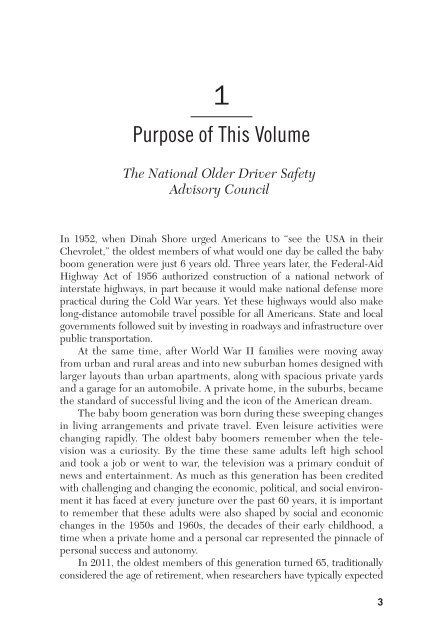Personal Choices and Public Policy - Springer Publishing
Personal Choices and Public Policy - Springer Publishing
Personal Choices and Public Policy - Springer Publishing
Create successful ePaper yourself
Turn your PDF publications into a flip-book with our unique Google optimized e-Paper software.
1<br />
Purpose of This Volume<br />
The National Older Driver Safety<br />
Advisory Council<br />
In 1952, when Dinah Shore urged Americans to “see the USA in their<br />
Chevrolet,” the oldest members of what would one day be called the baby<br />
boom generation were just 6 years old. Three years later, the Federal-Aid<br />
Highway Act of 1956 authorized construction of a national network of<br />
interstate highways, in part because it would make national defense more<br />
practical during the Cold War years. Yet these highways would also make<br />
long-distance automobile travel possible for all Americans. State <strong>and</strong> local<br />
governments followed suit by investing in roadways <strong>and</strong> infrastructure over<br />
public transportation.<br />
At the same time, after World War II families were moving away<br />
from urban <strong>and</strong> rural areas <strong>and</strong> into new suburban homes designed with<br />
larger layouts than urban apartments, along with spacious private yards<br />
<strong>and</strong> a garage for an automobile. A private home, in the suburbs, became<br />
the st<strong>and</strong>ard of successful living <strong>and</strong> the icon of the American dream.<br />
The baby boom generation was born during these sweeping changes<br />
in living arrangements <strong>and</strong> private travel. Even leisure activities were<br />
changing rapidly. The oldest baby boomers remember when the television<br />
was a curiosity. By the time these same adults left high school<br />
<strong>and</strong> took a job or went to war, the television was a primary conduit of<br />
news <strong>and</strong> entertainment. As much as this generation has been credited<br />
with challenging <strong>and</strong> changing the economic, political, <strong>and</strong> social environment<br />
it has faced at every juncture over the past 60 years, it is important<br />
to remember that these adults were also shaped by social <strong>and</strong> economic<br />
changes in the 1950s <strong>and</strong> 1960s, the decades of their early childhood, a<br />
time when a private home <strong>and</strong> a personal car represented the pinnacle of<br />
personal success <strong>and</strong> autonomy.<br />
In 2011, the oldest members of this generation turned 65, traditionally<br />
considered the age of retirement, when researchers have typically expected<br />
3
















